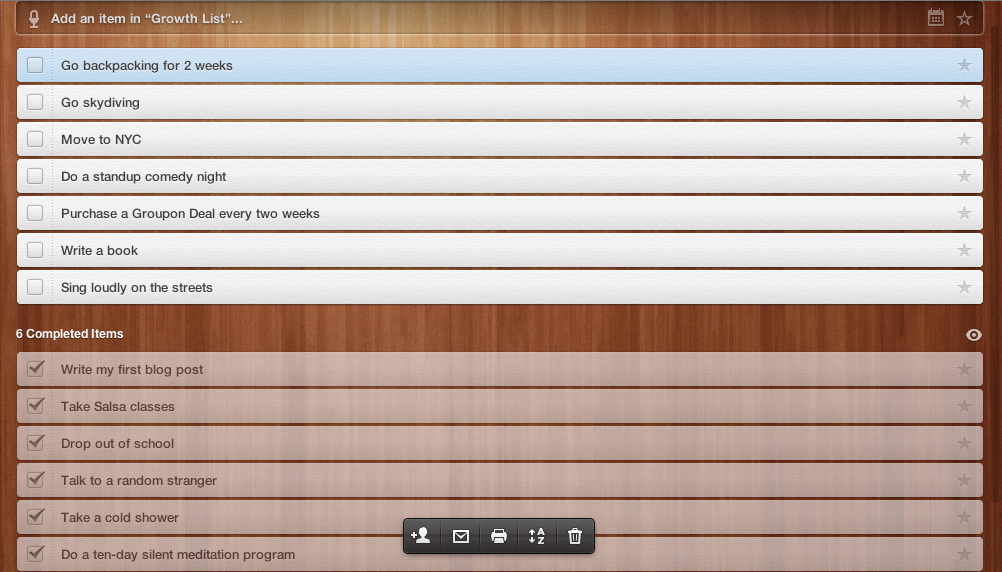How to stop giving a fuck what people think.
By @sseankim
We tip toe our way through life by doing things in order to please others, not because it’s what we believe in. Eventually our actions, appearances, and lives become moulded by how we think other people perceive us.How are these pants going to make me look? What will my colleagues think if I spoke out? Are those people talking shit behind my back? If I take this job, what will my friends and family think of me?Just writing that paragraph alone gave me a headache…
It’s exhausting. It’s dreadful. It has to stop.Living a life that follows the ideal notions of what other people think is a terrible way to live. It makes you become the spineless spectator who waits for other people to take action first. It makes you become a follower.
Worst of all, it makes you become someone who doesn’t take a stand for anything.Today is the last day we live a life dictated by others. Today, we’re going to get to the bottom of the truth. Today is the day we stop giving a F@$%.
No one really cares
Believe it or not, we’re not that special.
We go through our days thinking about how other people might be judging us. But the truth is — those people are thinking the exact same thing.
No one in today’s “smartphone crazed” society has time in their schedule to think more than a brief second about us. The fact of the matter is, when we do have time get our thoughts straight, we’re too busy thinking about ourselves and our own shortcomings — not others.
A study done by the National Science Foundation claims that people have on average 50, 000 plus thoughts a day. This means that even if someone thought about us ten times in one day, it’s only 0.02% of their overall daily thoughts.
“You’ll worry less about what people think about you when you realize how seldom they do.” — David Foster Wallace
It is a sad but simple truth that the average person filters their world through their ego, meaning that they think of most things relating to “me” or “my.” This means that unless you have done something that directly affects another person or their life, they are not going to spend much time thinking about you at all.
I’ve always enjoyed watching performers trying to hustle some change at the New York City train stations. These guys simply don’t give a F@$%.
But the more interesting observation I made is how the spectators react. Rather than watching the actual performers, most people are looking around to see how other people are reacting. If people were laughing, they would start laughing too. But if people weren’t paying attention, they would also pay no mind.

Even when provided the blatantly obvious opportunity to judge someone, people are still thinking about how others may perceive them.
Once you understand that this is how people’s mind works, it’s a big step towards freedom.
You can’t please everyone
It’s impossible to live up to everyone’s expectations.
There will always be people — no matter what we say or how we treat them — that will judge us. Whether you’re at the gym, at work, taking the train, or even online playing Call of Duty. Even now it‘s happening. You will never be able to stop people from judging you, but you can stop it from affecting you.
Think about the worst thing that could possibly happen when someone is judging you or what you’re doing.
I guarantee that chances are — nothing will happen. Absolutely nothing.No one is going to go out of their busy lives to confront us, or even react for that matter. Because as I mentioned before, no one actually cares. What will happen, is that these people will actually respect you for claiming your ground. They may disagree with you, but they’ll respect you.
Start standing up for what you believe in — causes, opinions, anything. You’re going to have people that disagree with you anyways, so why not express how you truly feel?
“You have enemies? Good. That means you’ve stood up for something in life.”— Winston Churchill
I’ve learnt that it’s better to be loved by a few people you care about, than to be liked by everyone. These are family, friends, spouse — the people who love you for who you are, and the people who will be there for you during your worst times. Focus on these people. They’re the only people that matter.
You reap what you sow
Worrying too much about what other people think can become a self-fulfilling prophecy, because the way we think starts to become the way we behave. These individuals become people-pleasers and overly accommodating to others, thinking it will stop them from being judged.
In fact, the opposite is true. Most people don’t like push-overs and are turned off by it. The behaviour we use in an attempt to please others, can actually cause the opposing effect.
If how we think affects our behaviours, then how we behave affects who we attract.
This means that if you’re a push-over, then you’re going to be attracting others in your life who are also push-overs. Vice versa.
This can be quite a dangerous path to go down if you don’t recognize its consequences.
It’s been said that we are the average of the five people we hang out with the most. When we start to attract and associate with the same people that share our weaknesses — we’re stuck. We stop growing, because there’s no one to challenge us to be better. We start thinking that this is the norm and we remain comfortable. This is not a place you want to be.
Now let’s talk about the cure. Here are 5 ways to stop giving a F@$%.
Reclaiming your freedom
1. Know your values
First and foremost. You need to know what’s important to you in life, what you truly value, and what you’re ultimately aiming for. Once you know who you really are and what matters to you, what other people think of you become significantly less important. When you know your values, you’ll have something to stand up for — something you believe in.
You’ll stop saying yes to everything. Instead, you’ll learn to say no when friends pressure you to go bar-hopping, or when a tempting business opportunity that distracts you from your business.
When you have your values straight, you have your shit straight.
2. Put yourself out there
Now that you know what your values are, it’s time to put yourself out there.
This can be done several ways. Here are a few suggestions:
- Blogging
- Wearing a polka-dot sweater
- Public Speaking
- Flirting/Asking someone out
Keep in mind that when you’re doing any of these activities, you have to speak your mind. Be honest with yourself and what you share, because the world doesn’t need another conflict-avoider who does what everyone else does.
3. Surround yourself with pros
Surround yourself with people who are self-assured, and live life without comprising their core values. These people will rub off on you quickly.
One of my best friends, Cody, has been a big influence on me. Having spent the summer with him, I’ve observed countless times where he strongly voiced his opinion on controversial topics. What I learned was that he was simply voicing opinions that people already had in their heads, but were too afraid to voice. People admired him for being so honest and direct, even when they disagreed with his views.
Thanks for not giving a F@$% Cody.
4. Create a “Growth List”
OK, now we’re getting personal.
I haven’t told anyone this, but I have this list called the “Growth List.”
A Growth List is comprised of all the things in life that makes you uncomfortable. These are fears, insecurities —anything that gives you the jitters.

Here’s how it works.
You start by writing all the things that make you feel uncomfortable.
Then one-by-one, you do them. Once you complete the task, you move on to the next. Repeat.
My first growth task was taking a cold shower. I turned the water as cold as it could get, and I could feel my body shake before I even entered the shower.This was the inner bullshit voice in my head talking.
It was hard at first. But surprisingly, it got easier the second time. Then even easier the third time. Before I knew it, my body stopped shaking — I was no longer uncomfortable, I’ve conquered my fear.
This exercise does wonders. I have yet to find a better way to get out of my comfortable zone. You can read all the books in the world about being confident or getting over your fears, but if you don’t take action, you’re just someone who’s read how to ride a bicycle without ever having ridden one.
5. Travel alone
If you’re looking for an ultimate transformation that combines all of the points above, you should travel alone. Traveling with other people can be fun, but you won’t get the opportunity to truly get out of your comfort zone.
You’ll be exposed to different social cultures, break social norms that you didn’t even know existed, and ultimately be forced to burst out of your small bubble.
Bring as little as possible, and fit everything into one backpack. Plan nothing, except for a one-way flight ticket to your destination — figure everything else out when you’re there. Trust me, you’ll be just fine.
It won’t be easy initially, but don’t get discouraged. Being comfortable with the uncomfortable will grow with time. I continue to struggle with it everyday, as do many others. But you need to get started today.
The world is already full of people who obey the status quo. But the people who don’t give a F@$% are the ones that change the world.
Be the latter.
Start living life the way you want, be fearless like you once were as a child, and always, always stand up for the truth.
Someone has to.
If you found this article helpful, share it with your loved ones. You can find me on Twitter @sseankim.
——————————————————————————-
Originally by my good friend, Sean Kim, posted at https://medium.com/life-hacking-2/46bf86584c95. Reposted with permission, good content deserves to be shared! If you use Medium, give him a recommendation if you liked it.

